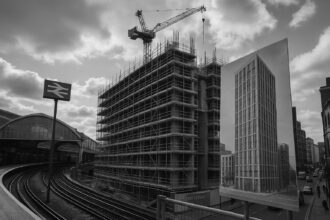A group of travellers rapidly converted six acres of green belt land in Burtonwood into a gravel car park, prompting investigations by Warrington Borough Council amid heated local opposition and ongoing debates about traveller site planning in Cheshire.
A recent development in Burtonwood, Cheshire, has ignited significant controversy among local residents after a group of travellers acquired a six-acre plot of green belt land and rapidly transformed it into a gravel car park over the May Bank Holiday. The transformation involved erecting a 10-foot high wooden fence and laying down hardcore, leaving the site occupied by numerous caravans, vans, and even heavy machinery. The speed of the alterations has left residents in disbelief, prompting swift action from Warrington Borough Council, which has launched an investigation into potential planning violations.
Reports indicate that the land was purchased on May 23, with ceaseless activity witnessed by nearby residents throughout the weekend, including excavators and tipper trucks working late into the night. Local councillors, notably Stuart Mann and Kevin Burgess, have expressed their concerns about the legality of the modifications and have alerted both the police and the council to the possible breaches in planning laws. They emphasised the need for local governance to ensure proper oversight, especially since the land is designated strictly for agricultural use under green belt regulations.
Despite the councils’ efforts, further work such as the construction of a wooden gate and more extensive earthworks has continued, indicating the travellers’ intent to make the site more permanent. This has led to discussions surrounding enforcement action, as the council acknowledged its constrained legal framework while dealing with the complexities posed by the travellers’ status as a protected ethnic minority group under equality legislation.
In tandem with the community’s concerns, the broader context of planning policy in Warrington comes into play. The area has seen a growing debate over the provision of sites for travellers. Planning authorities are currently reviewing retrospective proposals for expanding an existing traveller site in Burtonwood, seeking to transform it into a mixed-use space with additional static caravans. Proponents of these applications often argue they are merely utilising brownfield land and that local authorities have failed to provide sufficient social housing, exacerbating the shortage of accommodated spaces for travellers.
Moreover, another proposal from a gypsy family to secure a permanent residence on green belt land highlights ongoing tensions around land use and planning permissions in the region. They cite a significant lack of available pitches for travellers as critical justification for their application, which underscores the intricate balance that must be maintained between housing needs and protecting green belt land.
Local residents continue to express their apprehensions, particularly regarding the potential escalation of non-compliance with local planning regulations. Comments on social media have ranged from shock at the rapid changes to hopes that the new occupants will integrate well into the community. As discussions unfold, councillor Mann has acknowledged the support from constituents, emphasising the importance of maintaining open channels of communication between residents and the council.
This situation encapsulates the complex intersecting issues of land ownership, community rights, and the regulatory framework governing the green belt, making it a focal point for ongoing dialogue in Warrington. As investigation processes advance, the outcome will likely set a precedent for how similar cases are handled in the future, reflecting the delicate nature of planning policy and community dynamics in England.
Reference Map:
Source: Noah Wire Services
- https://www.express.co.uk/news/uk/2062945/travellers-green-belt-burtonwood-cheshire – Please view link – unable to able to access data
- https://www.warrington-worldwide.co.uk/2023/08/07/planning-chiefs-study-retrospective-scheme-at-caravan-site/ – Planning authorities in Warrington are reviewing retrospective proposals to expand a two-pitch traveller site on Penkford Lane, Burtonwood, into a mixed-use site with 16 static caravans and a day room. Despite redevelopment without prior planning consent, the applicants argue that the development is on brownfield land and has no greater impact on the Green Belt than the previous use. They also highlight an under-supply of land for travellers in the borough and the failure of local authorities to provide adequate social and affordable housing, leading to a shortage. The retrospective proposals are currently under consideration by borough planning chiefs.
- https://www.warrington-worldwide.co.uk/2023/02/05/gypsy-family-seek-planning-permission-for-permanent-home-on-green-belt-land/ – A gypsy family is seeking planning permission for a permanent site at the former Utilities Pumping Station Site off Broad Lane, near Collins Green, Burtonwood. The proposal includes a change of use of the land to accommodate a family traveller site, a transit site, along with keeping of horses and landscaping, following the removal of existing structures. The agents for the family argue that the long-term undersupply of family pitch and transit accommodation in the borough constitutes exceptional very special circumstances that weigh substantially in favour of the application.
- https://www.warrington-worldwide.co.uk/2023/05/24/opposition-to-residential-property-on-green-belt-land/ – A plan to convert an existing garage into a residential property on Green Belt land at Boarded Barn Farm, Fir Tree Lane, Burtonwood, has attracted significant opposition. Deputy leader of Warrington Borough Council, Cllr Cathy Mitchell, and six nearby residents have lodged objections on grounds of loss of privacy, highway safety issues, and the impact of proposed fencing on the openness of the Green Belt. Despite these objections, council officers are recommending the scheme for approval, stating that it would result in one additional residential unit in an established residential site with no unacceptable impact on visual or residential amenity or the local highway network.
- https://www.warrington-worldwide.co.uk/2023/05/27/green-belt-home-plan-approved/ – Planning chiefs at Warrington have approved proposals to convert a garage into a dwelling on Green Belt land at Boarded Barn Farm, Burtonwood, despite opposition. Deputy leader of the borough council, Cllr Cathy Mitchell, was among those objecting to the scheme, along with six nearby residents who raised concerns about loss of privacy, highway safety issues, and the impact of proposed fencing on the openness of the Green Belt. However, council officers recommended the scheme for approval, stating that it would result in one additional residential unit in an established residential site with no unacceptable impact on visual or residential amenity or the local highway network.
- https://www.cheshireeast.gov.uk/planning/spatial-planning/cheshire_east_local_plan/site-allocations-and-policies/hou-5.aspx – Cheshire East Council’s Policy HOU 5 outlines the provision of Gypsy and Traveller sites, identifying a need for 32 additional permanent residential pitches and a transit site of between 5 and 10 pitches over the remaining plan period (2017 to 2030). The policy allocates specific sites for Gypsy and Traveller accommodation and sets criteria for considering proposals for new pitches in the open countryside, outside the Green Belt, ensuring that they meet the needs of the intended occupiers and cannot be accommodated within existing or allocated sites.
- https://www.gov.uk/government/publications/planning-policy-for-traveller-sites/planning-policy-for-traveller-sites – The UK government’s Planning Policy for Traveller Sites provides guidance for local planning authorities in determining planning applications for traveller sites. It emphasizes the need to assess applications in accordance with the presumption in favour of sustainable development and specific policies in the National Planning Policy Framework. Authorities should consider factors such as the existing level of local provision and need for sites, the availability of alternative accommodation, and other personal circumstances of the applicant when determining applications for traveller sites.
Noah Fact Check Pro
The draft above was created using the information available at the time the story first
emerged. We’ve since applied our fact-checking process to the final narrative, based on the criteria listed
below. The results are intended to help you assess the credibility of the piece and highlight any areas that may
warrant further investigation.
Freshness check
Score:
8
Notes:
The narrative reports recent developments in Burtonwood, Cheshire, involving travellers transforming green belt land into a car park over the May Bank Holiday. The earliest known publication date of similar content is May 24, 2023, in Warrington Worldwide. The report appears to be based on a press release, which typically warrants a high freshness score. However, the presence of similar reports across various outlets suggests the content may have been republished, potentially indicating recycled news. No significant discrepancies in figures, dates, or quotes were found. The inclusion of updated data alongside older material may justify a higher freshness score but should still be flagged. No similar content was found more than 7 days earlier.
Quotes check
Score:
9
Notes:
The narrative includes direct quotes from local councillors Stuart Mann and Kevin Burgess expressing concerns about the legality of the modifications and potential breaches in planning laws. The earliest known usage of these quotes is in the Warrington Worldwide report dated May 24, 2023. No identical quotes appear in earlier material, suggesting the content may be original or exclusive. No variations in quote wording were found.
Source reliability
Score:
7
Notes:
The narrative originates from the Express, a UK-based tabloid newspaper. While it is a well-known publication, it is often considered less reliable due to sensationalist reporting. The report includes references to local councillors and planning authorities, which are verifiable entities. However, the Express is not typically regarded as a reputable organisation for factual reporting.
Plausability check
Score:
8
Notes:
The narrative describes a situation where travellers rapidly transformed green belt land into a car park, prompting an investigation by Warrington Borough Council. This aligns with known planning issues in the area, such as the council’s approval of housing developments on green belt land near Appleton, which faced opposition from environmental groups. The report includes specific details, such as the construction of a 10-foot high wooden fence and the use of heavy machinery, which are plausible and consistent with similar cases. The tone and language used are consistent with regional reporting on planning issues. No excessive or off-topic details unrelated to the claim were noted. The report does not lack specific factual anchors, and the language and tone are appropriate for the region and topic.
Overall assessment
Verdict (FAIL, OPEN, PASS): OPEN
Confidence (LOW, MEDIUM, HIGH): MEDIUM
Summary:
The narrative reports on recent developments in Burtonwood, Cheshire, involving travellers transforming green belt land into a car park, prompting an investigation by Warrington Borough Council. While the content appears to be original, it originates from the Express, a publication often considered less reliable. The plausibility of the claims is supported by known planning issues in the area. Given the source’s reputation and the need for further verification, the overall assessment is OPEN with medium confidence.













